Bulk-generate & schedule posts in seconds with Smart Scheduling. Try now!
Share of voice: Definition, calculation & growth strategy

Never heard of “share of voice” before? Well, it’s an essential social media concept that determines a brand’s overall position on the social media canvas as compared to competitors.
Social media marketing has undergone rapid changes over the past few years. The challenge of being relevant on countless social media channels pushes users to put out a plethora of social media posts across multiple social platforms.
With over a billion social media posts being published every day, it often gets challenging to keep up with competitors as coming up with interesting social media content ideas consistently is no easy feat, let alone making a mark with your brand’s share of voice.
If you’re interested in knowing more about why the share of voice is important, its types, and how to calculate it, then stick around and continue reading this!
What is the share of voice?
Share of voice is used to examine a brand’s reach, visibility, and influence within the market conversations. The more shares a brand gathers, the greater success it enjoys.
However, it’s important to comprehend that SOV isn’t a static score. It’s highly influenced by factors such as consumer interests, competitor offerings, and environmental situations.
It’s vital to understand that SOV isn’t a combination of different social media metrics. Instead, it’s more like overseeing the market conversation to identify the share of a specific brand.
Share of voice definition
Share of voice (SOV) is a mechanism used to analyze the market conversations and identify a brand’s position as compared to the competitors. Simply put, it’s a system to find out how deeply rooted a brand is among social media conversations in contrast to its competitor brands.
Historical context of share of voice
Share of voice (SOV) began as a concept in traditional advertising, where it measured how much advertising space or airtime a brand had occupied in comparison to its competitors.
Initially, it focused solely on paid traditional media, such as print ads, radio spots, and television commercials.
However, with the growth of digital marketing, the definition of SOV has expanded to include online visibility, including social media activity, mentions across the web, organic search rankings, and even direct website traffic.
Share of voice in traditional vs. digital media
Let’s discuss the concept of share of voice (SOV) in traditional versus digital media:
SOV in traditional media
SOV is essentially used to track how much is spent on ads and how often a brand appears in traditional media like newspapers, radio, and TV. It calculates the share of paid media space a brand holds compared to competitors in the industry. Basically, in traditional media, the SOV revolves around the exposure received through paid advertising campaigns.
SOV in digital media
Digital marketing has turned things around for everyone. It now covers digital mentions, interactions on social media (via DMs, comments, and likes), and visibility in organic search results (SEO). This evolution allows marketers to gain a more holistic view of a brand’s presence and influence online, which paves the way for understanding the overall SOV of a brand.
Why share of voice matters for your brand
Share of voice analysis provides essential insights into a brand’s position in the market and helps teams see through the social media vanity metrics.
Before diving deep into various types of SOV metrics and different methods to calculate the SOV, let’s quickly shed some light on why SOV matters for a brand:
Brand visibility
SOV enables the individual or company to analyze the brand visibility across multiple social media platforms. Brand visibility refers to the appearance of the brand name in conversations. In other words, it showcases how many times or how many people mention the brand name on social media.
Competitor analysis
One of the reasons why SOV matters for a brand is to figure out where its competitors stand in the market. Whether you’re social listening or randomly following a hashtag, it’s vital to keep up with the competitors’ activities to see where your brand stands.
Audience insights
Share of voice is a tactical method to find out how effective the brand messaging has been over the course of a period. It works as an indicator to showcase how aligned your brand communication is with your target audience.
Performance measurement
Share of voice measures how vibrant and effective your content strategy is as compared to the market share of competitors. Performance measurement allows you to analyze how well your social media content is doing and where it can still be improved for better ROI.
Strategic shifts
Strategic shifts are essential to navigate a successful digital marketing strategy. However, when a competitor is dominating a specific segment of the niche in Google search or YouTube, it becomes imperative for you to recalibrate the content strategy to gain some portion of the space.
These are some of the reasons why every brand needs to pay close attention to the share of voice.
Types of share of voice metrics
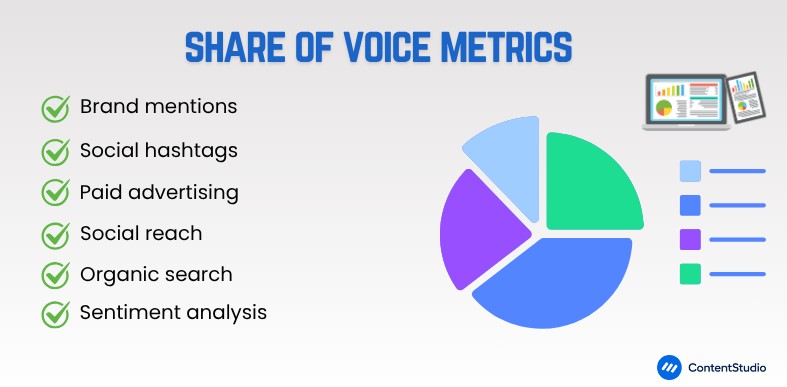
Several SOV metrics are available that indicate the brand’s presence and visibility in the market. Let’s talk about some of the important ones:
Brand mentions
It’s a share of voice metric that tracks how often your brand is mentioned across various online platforms, including news sites, blogs, forums, and social media. It’s a direct measure of brand visibility and awareness. A higher number of mentions compared to competitors indicates a stronger share of voice in the conversation.
Social hashtags
Hashtags are an essential part of social media content publishing. This type of SOV showcases how frequently branded or campaign-specific hashtags are used on platforms like X (Twitter), Instagram, or TikTok. Monitoring hashtag usage helps assess brand engagement, campaign reach, and audience interaction. Comparing your hashtag’s usage against those of competitors gives insight into your SOV on social platforms.
Paid advertising
Paid advertising directly influences the digital marketing campaign. The paid advertising SOV measures the visibility of your brand through paid channels such as Google Ads, Facebook Ads, or display networks. It often includes metrics like impression share, ad frequency, clicks, CTR, and reach.
Social reach
Social reach estimates the total number of unique users who see your content on social media. This metric uses analytics data of your posts, shares, and mentions. A larger reach, as compared to others, shows stronger brand visibility and influence on social platforms.
Organic search
Organic search is a metric that reflects how often your brand appears in unpaid search engine results, especially on relevant keywords. It includes keyword rankings, click-through rates, and organic traffic share. A higher organic traffic indicates stronger SEO performance and a larger share of voice on the organic search front.
Sentiment analysis
While sentiment analysis might not be a volume metric, it still adds a qualitative layer to SOV. It evaluates whether the mentions or discussions about your brand are positive, negative, or neutral. Understanding the emotional tone helps gauge brand perception and refine messaging across the board.
These are some of the important types of share of voice metrics brands should keep an eye on.
How to calculate the share of voice
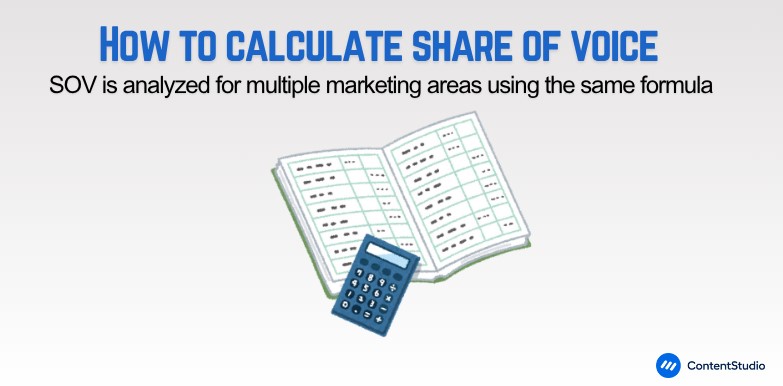
It’s not rocket science to calculate the share of voice. It’s important to acknowledge that SOV is analyzed for multiple marketing areas. Let’s find out the formula to calculate the SOV and briefly touch on different marketing areas where SOV is calculated:
Share of voice formula
Before we hop on different sectors where the share of voice matters and is calculated for marketers’ and brands’ assistance, let’s get the SOV formula out of the way.
Here’s the share of voice formula:
Share of voice = brand metrics / total market metrics
So, divide your brand metrics by the total market metrics to calculate the share of voice. This formula applies to almost every major marketing channel, and we’re about to shed some light on the few.
Share of voice on social media
Share of voice (SOV) on social media is an essential metric that showcases how much attention and visibility your brand gets on social media as compared to competitors. The process begins with capturing real-time consumer engagement, brand mentions, and public sentiment across platforms like Instagram, X (Twitter), Facebook, TikTok, and LinkedIn.
To measure SOV on social media effectively, several social listening tools are available to do the job. They automatically track brand mentions, hashtags, and keywords, giving you a clear picture of your brand’s presence without the need for manual searching.
These tools help brands and influencers find out who is talking about their brand, how often, and in what context.
Share of voice in PR
The same formula calculates the share of voice (SOV) in public relations (PR). However, the only difference is that SOV in PR is analyzed beyond the social media spectrum.
Primarily, when a brand is visible on earned media in comparison to its competitors, it falls in the share of voice in the PR section. The earned media refers to media outlets, magazines, social channels, and other publications.
The SOV in PR is calculated by the mentions of the brand as compared to its competition.
Share of voice in PPC
When it comes to share of voice calculation in PPC advertising, it heavily relies on the impression share. In other words, it indicates the percentage of times a brand’s ads are displayed compared to the overall number of ad impressions.
It’s essentially a vital metric for understanding a brand’s visibility and reach in paid search results relative to its competitors. It tells us how effectively a brand is running its PPC campaigns as compared to its arch-rivals.
Share of voice in SEO
Since SEO is all about winning the top spots in the search engine result pages (SERPs), the share of voice in SEO refers to the position a brand holds as compared to its competitors.
It’s the percentage of SEO opportunities a brand has grabbed in comparison to its competitors. It also explains the share of voice the brand has had in the SEO space.
So, these are some of the share of voice calculation methods that digital marketers use when analyzing their brand or client’s market share in a specific discipline.
Strategies to increase the share of voice
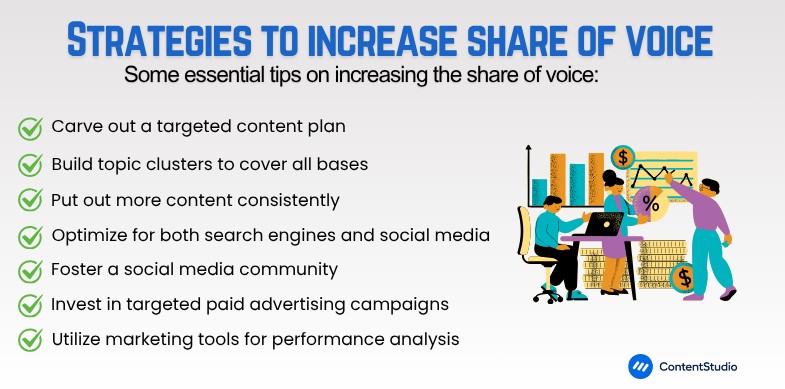
Increasing your brand’s share of voice becomes inevitable to survive, especially when there is cut-throat competition in the market. Here are some essential tips on increasing the share of voice:
Carve out a targeted content plan
To dominate your niche and increase your share of voice, you must create a specific, well-targeted content plan that sifts through the noise and helps your brand reach the prospective audience.
There is no point in creating less helpful, irrelevant content that doesn’t resonate with your target audience. So, sharpen your overall brand content strategy that hits the bullseye.
Social Media Content Calendar
Stay consistent and organized with Contentstudio’s social media content calendar for marketers and agencies.
Get Started for FREE
Build topic clusters to cover all bases
Categorize your content across multiple segments; it can be categorized on the blog and hashtags on social. The purpose is to have multiple topic clusters that are relevant to your industry.
Cover each topic cluster in detail so that your brand starts to appear everywhere when searching for that topic. Each topic cluster on the blog can cover somewhere between 30 to 60 articles, depending on the depth of the topic.
Creating a few dozen such clusters can take your content strategy to the next level, which eventually skyrockets website organic traffic and improves the share of voice.
Put out more content consistently
You can’t increase your brand’s share of voice by being silent. You have to get out there and put out content to challenge the competitors in the space. The more you put out your content, the easier it becomes to reach the audience.
Publishing content across multiple marketing avenues would increase your chances of building dominance and ranking well. So, don’t underestimate the power of consistency in publishing content, no matter what platforms you choose for content marketing.
Optimize for both search engines and social media
Content optimization is essential for both search engine rankings and social media growth. Ignoring the optimization can be fatal to your content publishing.
Find the relevant keywords and use them strategically in your content. Plus, internally link your articles so that they genuinely help the readers. Additionally, make your social media posts more clickable and attractive to get traction. All of this is just the tip of the iceberg.
Foster a social media community
A social media strategy is incomplete without fostering a powerful social media community of loyal and die-hard brand customers and followers. Building a social media community shouldn’t be difficult; you can start with a Facebook group, a Twitter list, or an Instagram group.
However, building a social media community isn’t limited to certain platforms. In essence, a social media community is a group of people with similar interests or tastes. For instance, top YouTube creators have a strong follower base that interacts with each other in the comments section and helps each other out.
So, brands can certainly increase their share of voice by paying attention to fostering a strong social media community.
Invest in targeted paid advertising campaigns
Sometimes, starting a targeted, thoughtful paid advertising campaign can turn things around for a brand. Usually, brands save up to launch paid advertising campaigns during the holiday seasons, such as Halloween, Black Friday, Thanksgiving, and Christmas.
Running a strategically planned paid advertising campaign can be a game-changer and increase a brand’s share of voice in the market.
Utilize marketing tools for performance analysis
Don’t shy away from capitalizing on marketing tools for content and engagement analysis. Start by investing in a powerful social media dashboard that helps you schedule and analyze social media content. ContentStudio is our go-to tool for that.
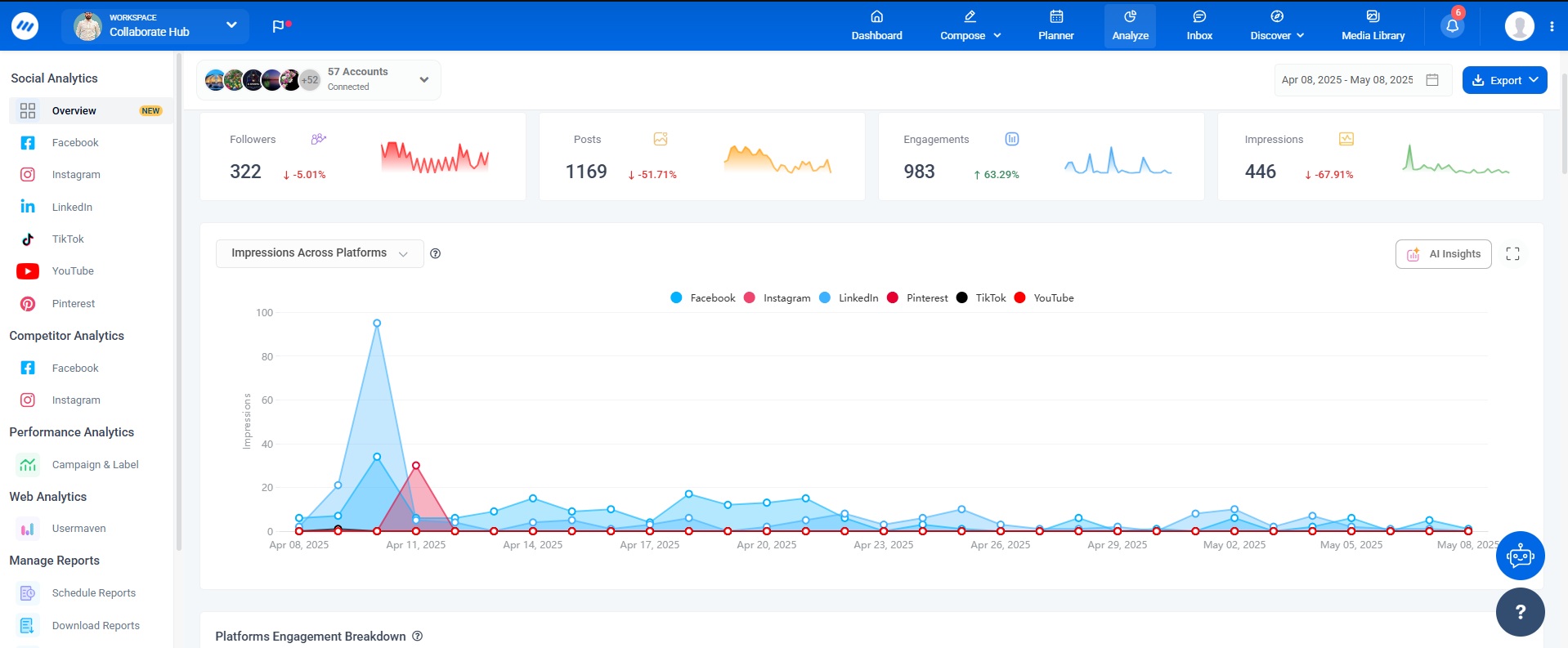
Secondly, use a website traffic analysis and tracking tool for monitoring your website traffic, keywords, backlinks, clickability, and organic traffic sources. Usermaven is a great tool for this purpose.
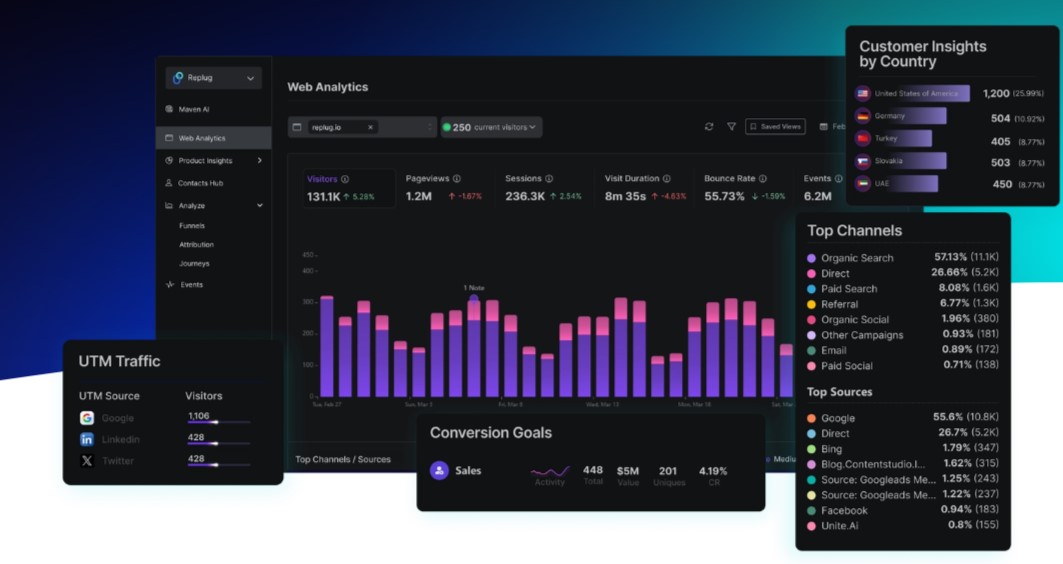
Utilizing such helpful marketing tools gives you essential insights into your content performance and website analysis. It eventually helps in understanding your brand’s share of voice in the market.
Top 4 tools to measure share of voice
Let’s take a quick look at five tools to use for measuring the share of voice for brands:
1. Ahrefs

Ahrefs is a powerful SEO analysis and website tracking tool widely used by SEOs, affiliate marketers, and professional bloggers across the globe. It helps marketers with tracking different engagement metrics, including the “visibility” metric to assess your share of voice for specific keywords, and tracks backlinks.
2. Usermaven
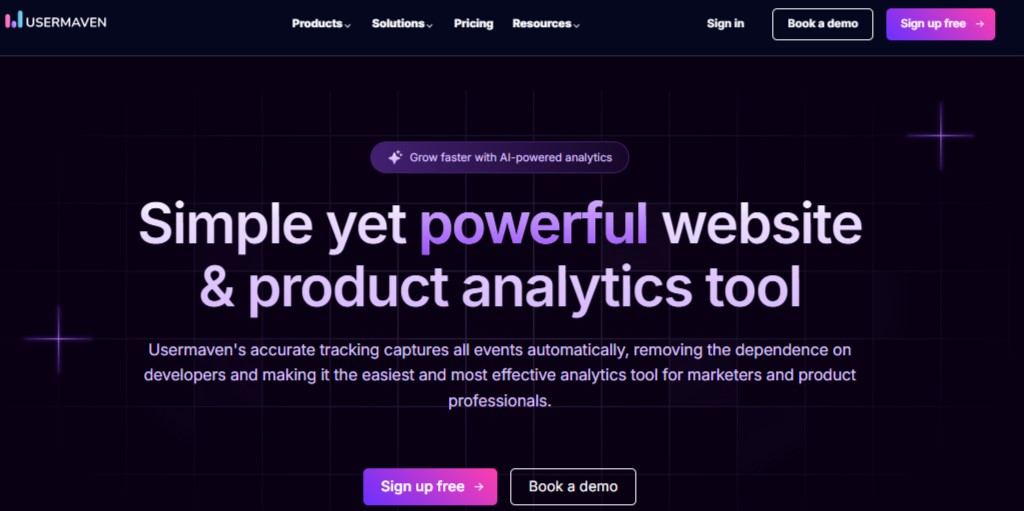
Usermaven is an AI-based website and product analysis tool that offers extensive monitoring features. It assists users in tracking multiple metrics, such as clicks, impressions, keywords, traffic sources, UTMs, and more. It becomes a huge helping hand to brands and individuals who are trying to comprehend their share of voice in the market.
3. Talkwalker
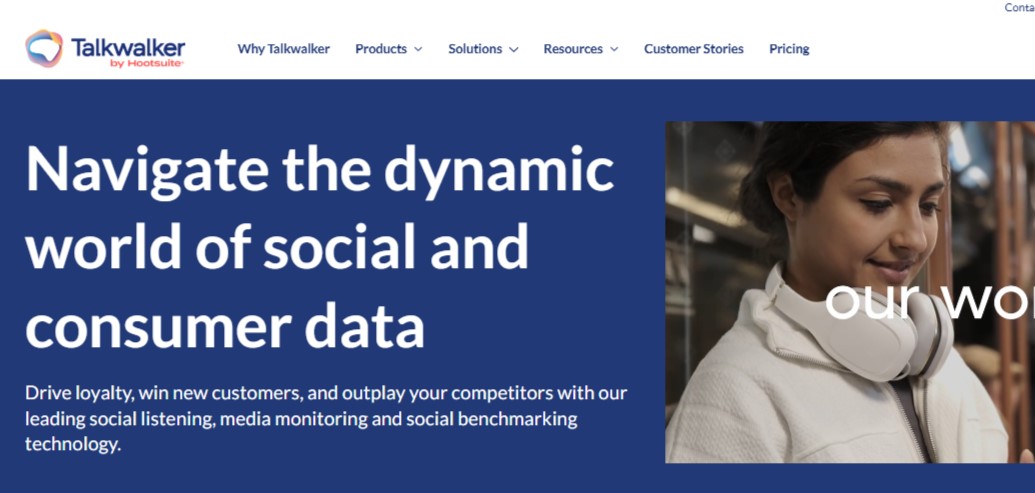
Talkwalker is one of the top-rated consumer intelligence platforms that helps brands monitor social media, blogs, news, and the web. It massively helps users (including both brands and individuals) understand their SOV and consumer sentiments.
4. Brand24
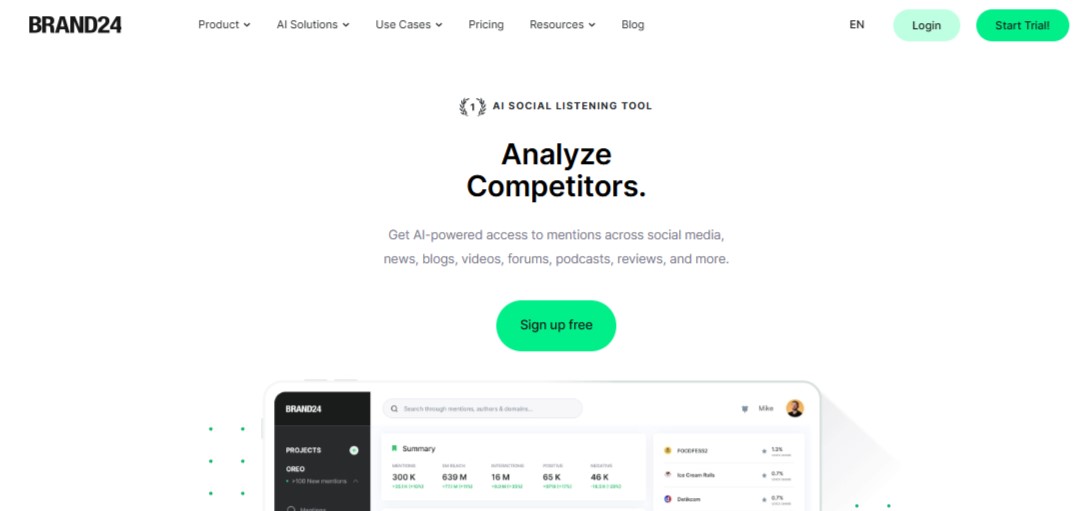
Brand24 is a well-known AI-powered social media listening tool that assists brands in monitoring media mentions, customer sentiment, and brand visibility across news media, blogs, search engines, and social media. All the essential brand insights create a clear picture of how a brand is being positioned among competitors.
So, these are five of the many tools to measure the share of voice for your brand.
Common challenges and how to overcome them
Here are the common challenges brands face when analyzing their share of voice and their solutions to overcome them:
1. Fragmentation across platforms
With conversations happening across various channels, such as social media, search engines, blogs, forums, and review sites, it becomes difficult to gather all the data in one place. Each platform has different algorithms, formats, and access limitations, making holistic analysis a challenge. This fragmentation leads to inconsistent or incomplete share of voice insights.
2. Inconsistent data sources
Different tools and platforms may track mentions, impressions, or reach using different definitions and criteria. As a result, comparing results from two tools can lead to conflicting conclusions. This inconsistency makes it hard for brands and experts to rely on a single, accurate measurement.
3. Difficulty in identifying brand mentions
Not every mention includes a hashtag or a brand tag. Many users refer to brands using slang, abbreviations, or misspellings, which automated systems may fail to detect. This leads to underreporting or misrepresentation of actual conversations about the brand.
4. Competitor benchmarking complexities
To truly measure the share of voice, brands must know how much attention their competitors are getting. However, accessing detailed, real-time competitor data is often restricted or unavailable. Additionally, choosing the right competitors for comparison is not always straightforward.
5. Understanding the paid vs. organic content outcome
Some brands dominate their share of voice through heavy paid promotions, while others rely on organic engagement. Comparing these two on equal terms can skew insights. It also makes it harder to distinguish genuine brand affinity from paid exposure.
6. Language and tone barriers add limitations
Understanding the tone and intent behind a mention is crucial but difficult. Sarcasm, cultural context, and language variations often confuse sentiment analysis tools. This can result in misleading sentiment scores that affect the perceived quality of the brand’s share of voice.
7. Volume doesn’t always equal impact
A high number of mentions doesn’t necessarily mean strong influence or engagement. Some mentions may come from low-impact sources or irrelevant contexts. Measuring actual influence or audience reaction is more important, but harder to quantify.
8. Real-time monitoring and changes
Share of voice is a dynamic metric that can change quickly based on events, trends, or campaigns. Monitoring it in real time and making sense of sudden spikes or drops requires constant attention and analytical capability. Many brands miss these shifts due to delayed reporting or a lack of actionable insights.
Conclusion
Share of voice is an essential growth metric for brands and influencers who are interested in understanding their brand position in the market. Usually, brands utilize social listening to keep an eye on customer sentiments and behaviors.
However, share of voice is a market share metric that explains how much space a brand or organization owns in the discussions. The reason why share of voice is important is that it reveals a brand’s popularity and relevancy in the market.
We tried to explain what it is and how a brand can utilize it for growth and social engagement.
FAQs
What does the SOV stand for?
SOV is an abbreviation for “share of voice,” which refers to the market share a brand owns in online conversations.
How do you calculate SOV?
To calculate the SOV, one must divide the brand metrics by the total market metrics.
Share of voice = brand metrics / total market metrics.
What does a 100% share of voice mean?
A 100% share of voice means there is no competition threat to the brand, which makes an ideal situation for a business to be in and skyrocket its growth in that monopolistic environment.
What is the purpose of SOV?
SOV is a market analysis metric that measures a brand’s visibility and presence in comparison to its competitors in the market. In essence, it’s used to help brands understand how much of the market conversation their brand dominates as compared to their competitors.
Recommended for you
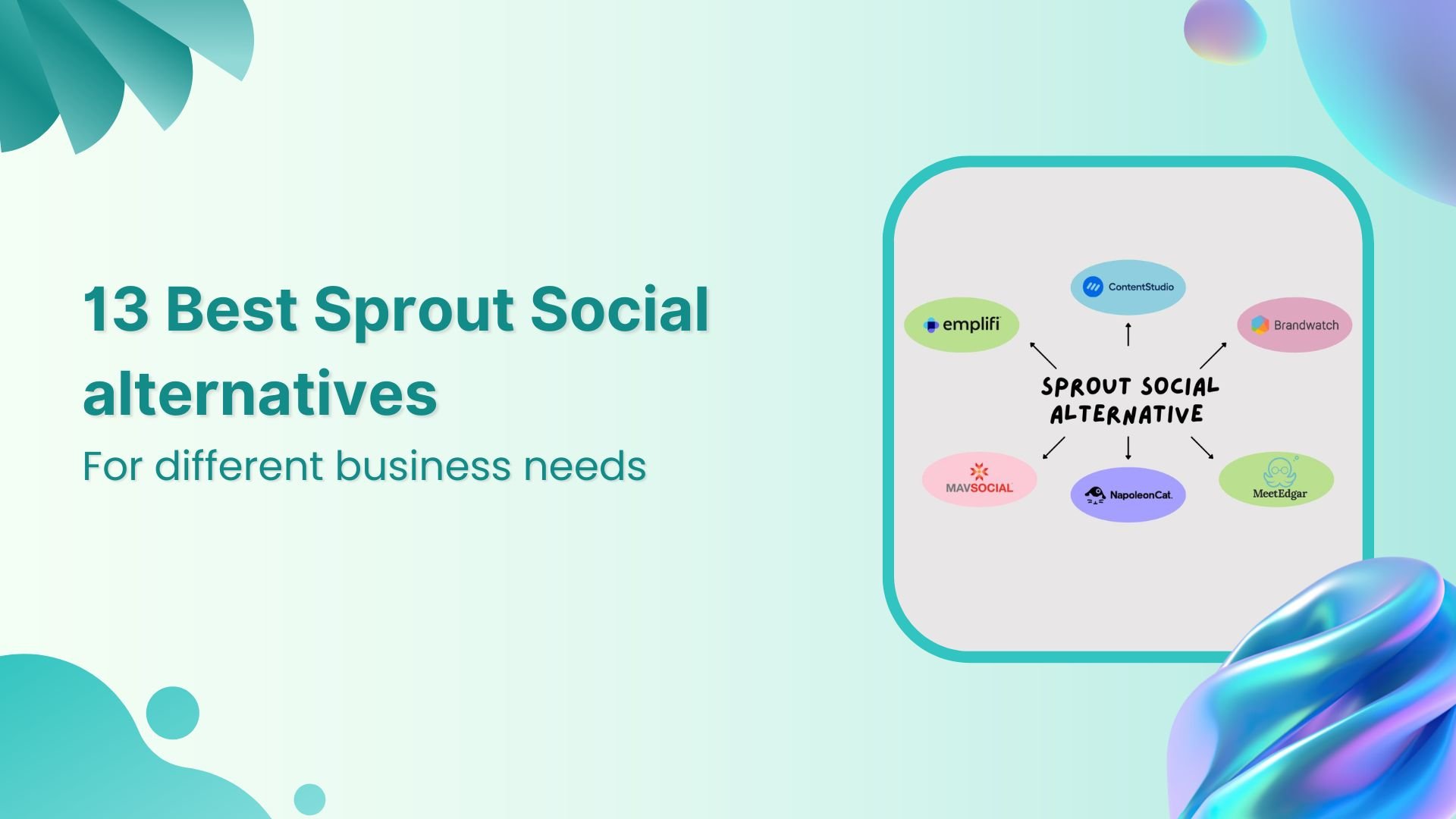
13 Best Sprout Social alternatives for effective social media management

150+ Black Friday quotes, hashtags, and slogans to boost sales

Why is an integrated marketing campaign beneficial for your brand?


Powerful social media management software
14-day free trial - No credit card required.
